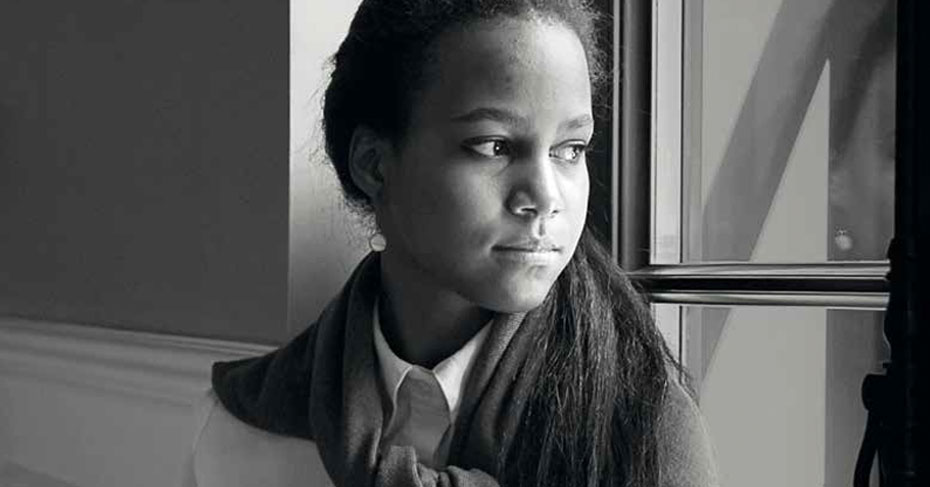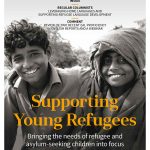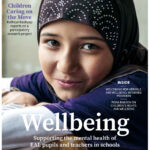How best to support children from a refugee background is a concern shared by educators with the increasing number of children arriving in schools from a variety of different ethnolinguistic backgrounds both in terms of looking after their language development but also their wellbeing. . In this blog, we bring you advice from EAL Journal columnist and EAL practitioner, Jonathan Bifield, as well as links to an interview with School of Sanctuary’s Sara Trewhitt and other EAL Journal articles on this important subject.
Christina Richardson
Jonathan Bifield on supporting the language development of refugee/asylum-seeking children
Language acquisition is essential for all learners and for refugee / asylum seeking children it is essential that teachers provide opportunities for acquisition to happen. Alongside a specific focus on language development it is vital that schools take a whole-school approach in supporting refugee / asylum seeking children. In particular, schools need to understand a child’s language background, prior educational experience and use these to support language acquisition.
Refugee / asylum seeking children enter schools at all age / grade levels and at various points throughout the academic year. The Bell Foundations’ (2022) excellent guidance on refugee and asylum seeking children suggests that all staff need clear, factual guidance prior to the child starting school. In my school, this happens at initial meetings with the student and other parties. I work with other key workers at the school in gathering as much evidence as possible so that we as a school can better understand how the whole school can support the student. Information that is essential includes: the languages the student can use as well as the languages the student is literate in, what prior educational experiences the student has had and also what, if any, exposure to the English language the student has had. This information is then shared with all staff, especially those members of the school who directly support the child.
Language acquisition plays an integral role in all EAL learners’ development. In a review of research into refugee children in the USA, McBrien (2005) suggests that refugee children viewed English language acquisition as important to their future success in their new country. Furthermore, there are dangers is the perceived risk that if refugee/asylum seeking children suffer have from poor English language skills then they can face alienation in their new country and school (Nicassio, 1983). In Australia, Kaplan et al. (2016) imply that refugee / asylum seeking children may have acquired a number of languages but may not have achieved proficiency in any of those languages. They found that this was especially pertinent to students that had travelled through several countries during their journey as a refugee or asylum seeker. Initial assessments of language proficiency can help schools in understanding how they can support refugee / asylum seeking children. Can the child read and write in any of the languages they have? If so, to what level? Knowledge of literacy in their language can have important implications especially when considering Cummins Interdependence hypothesis and how the first language (L1) can play an important role in the acquisition of the second language (Cummins, 1984).
Cummins’ interdependence hypothesis or common underlying proficiency model suggests that the cognitive and linguistic skills seen in the L1 transfer across all of a learners’ languages (NALDIC, 2011). Therefore, if a child is literate in their first language then it is possible to transfer literacy skills to the second language. Alternatively, if a child is not literate in their L1 this can have serious implications for learning any additional language(s). Kaplan et al (2016) found that some refugee / asylum seeking children in Australia were unable to communicate well in any of the languages they had. They suggest this could be due to a number of reasons that include an interrupted or poor education in their own country, or the fact that refugee / asylum seeking children often travel through many countries before settling meaning they might have had little or no access to formal education. Therefore, according to Cummins’ model, communicating in English might cause problems to some refugee / asylum seeking children. Hence, schools need to provide plenty of opportunities for language acquisition to happen and the best place for this to happen is in the classroom or subject being studied. This is because such places give language learning the context needed. There might be an assumption amongst some, that they need to spend some time acquiring a language before entering the classroom or subject. However, this is not the case as refugee / asylum seeking children need to hear good models of the language they are acquiring for language acquisition to take place.
Interventions and approaches to supporting refugee / asylum seeking children
Language development happens best within the curriculum or content area that is being studied. Kaplan et al (2016) highlight the potential gains that can be made through specific interventions for refugee / asylum seeking children. These include making modifications to the language of tuition, bridging programs, whole-school approaches as well as trauma-focused interventions. Newcomer et al (2020) found that scaffolding instruction and using refugee / asylum seeking children’s own experiences also helped with language acquisition. Their research conducted in a school in the USA with 75% of the children being of refugee / asylum seeking background found that experienced teachers used a range of support strategies that included: student partnerships, labelled pictures and engagement in shared writing and language experience approaches. McBrien (2005) also suggests the Language Experience Approach (LEA) could be one of the best ways to support language acquisition in refugee / asylum seeking children. This is because the approach uses students’ personal experiences to help increase language capabilities. Using refugee / asylum seeking children’s own experiences can play a vital role in language development and teachers need to foster opportunities for this to happen.
Click here to watch the full interview with Sara Trewhitt from the School of Sanctuary
The Language Experience Approach (LEA) in Supporting Language Acquisition
The LEA suggests language development happens through a combination of speaking, listening, reading and writing activities. Furthermore, these activities should be based on first hand experiences which might include everyday events, experiences at school as well as students’ own personal experiences or ideas (Victoria State Government, 2019). The major advantages of using the LEA with refugee / asylum seeking children are that it draws on students’ own experiences and uses their language and vocabulary, thus, providing increased engagement and motivation in learning tasks. For refugee / asylum seeking children, teachers need to be sensitive to what experiences they tap into. Many refugee / asylum seeking children have to deal with extremely traumatic events and teachers must be careful what past experiences they ask their students to share whilst using the LEA. Having said that, refugee / asylum seeking children bring a wealth of experiences which can have a positive impact on the classroom. I have heard some amazing stories from some of my refugee / asylum seeking students which have opened both my eyes and other students’ eyes to a world which we have never experienced. Through the use of the LEA teachers can use refugee / asylum seeking children’s own experiences to support language acquisition.
Steps in Using the Language Experience Approach in the mainstream classroom
Although the LEA has been used widely in reading instruction it also has benefits in developing children’s oral language proficiency, vocabulary and understanding of sentence structure (Echevarria et al, 2013). The procedure for using the LEA in mainstream classrooms is:
- Discussion centred around student experiences related to a topic being studied in class. For refugee / asylum seeking children this could involve them talking about their home country or discussing an educational experience they have had in their host country.
- As students share their ideas, the teacher acts as a guide dictating what the refugee / asylum seeking students are saying. As the teacher, you select certain student generated sentences to scribe on a board, writing down what students share experiences. Refugee / asylum seeking students can get a lot of motivation from seeing their own words on the board.
- The teacher then reads the dictated text back to the students which can act as a way to model effective reading or speaking. From this point, teachers can get students to practise reading the text out loud or work in pairs or small groups to read the text.
- With the support of the teacher, students learn to recognise certain words and language structures. The aim being that students then use these words and language structures in their own speaking or writing activity. Further discussion could take place centred around changing certain words or language structures.
Where else can you find helpful information?
As a result of the terrible situation in Ukraine, the plight of refugee / asylum seeking children has risen to prominence here in the UK. There are some great resources available to all who want to provide the best support. I would highly recommend the pinned tweets of @EALDominicB and @BeeTheka which you can access via Twitter. Both provide comprehensive lists and links to ways we can all support refugee / asylum seeking children in our schools. As previously mentioned, The Bell Foundation provides a comprehensive list of ways schools can provide appropriate support as well as a wide range of classroom resources which can be used in the classroom or subject being studied.
In summary
Using refugee / asylum seeking children’s own experiences and language in the classroom can have enormous benefits which includes increased participation and more meaningful and enjoyable learning experiences. Refugee / asylum seeking children bring a wealth of experiences and life events into the classroom which can be used to enhance our classrooms and schools. Teachers and schools need to be sensitive to what information refugee / asylum seeking children share because of the extremely traumatic experiences that many of them go through. Through using the Language Experience Approach in the mainstream classroom our refugee / asylum seeking children’s language acquisition can develop.
References
Cummins, J. (1984) Bilingualism and special education. Clevedon: Multilingual Matters
Echevarria, J., Vogt, M.E., Short, D.J. (2013) Making Content Comprehensible for English Learners: The SIOP Model. USA: Pearson Education Inc.
Kaplan, I., Stolk, Y., Valibhoy, M., Tucker, A., Baker, J. (2016) ‘Cognitive assessment of refugee children: Effects of trauma and new language acquisition’, Transcultural Psychiatry, 53 (1), pp 81 – 109.
Lightner, L.K. (2020) ‘Whoa… Welcome to America!”: Supporting Refugee Background Students’ Socioemotional Well-Being, English Language Development, and Content Area Learning’, Journal of Research in Childhood Education, DOI: 10.1080/02568543.2020.1734697
McBrien, J.L. (2005) ‘Educational Needs and Barriers for Refugee Students in the United States: A Review of the Literature’, Review of Educational Research, 75 (3), pp. 329 – 364.
NALDIC (2011) Bilingualism and Second Language Acquisition. Available at: https://www.naldic.org.uk/eal-teaching-and-learning/outline-guidance/bilingualism/ (Accessed 19/6/2020).
Newcomer, S.N., Ardasheva, Y., Morrison, J.A., Ernst-Slavit, G., Morrison, J., Carbonneau, K.J.,
Victoria State Government (2019) The language experience approach. Available at: https://www.education.vic.gov.au/school/teachers/teachingresources/discipline/english/literacy/readingviewing/Pages/teachingpraclangexp.aspx (Accessed 16/6/2020)
Nicassio, P. M. (1983) ‘Psychosocial correlates of alienation: A study of a sample of Indochinese refugees’. Journal of Cross-Cultural Psychology, 14, 337–351.
The Bell Foundation (2022) Refugees and Asylum Seekers. Available at: https://www.bell-foundation.org.uk/eal-programme/guidance/diversity-of-learners-who-use-english-as-an-additional-language/refugees-and-asylum-seekers/ (Accessed 21/10/22)




